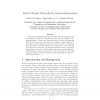Free Online Productivity Tools
i2Speak
i2Symbol
i2OCR
iTex2Img
iWeb2Print
iWeb2Shot
i2Type
iPdf2Split
iPdf2Merge
i2Bopomofo
i2Arabic
i2Style
i2Image
i2PDF
iLatex2Rtf
Sci2ools
CIMCA
2005
IEEE
2005
IEEE
Hybrid Neural Networks for Immunoinformatics
Hybrid set of optimally trained feed-forward, Hopfield and Elman neural networks were used as computational tools and were applied to immunoinformatics. These neural networks enabled a better understanding of the functions and key components of the adaptive immune system. A functional block representation was also created in order to summarize the basic adaptive immune system and the appropriate neural networks were employed to solve them. Training and learning accuracy of all neural networks were very good. Polymorphism, inheritance and encapsulation (PIE) learning concepts were adopted in order to predict the static and temporal behavior of adaptive immune system interactions in response to typical virus attacks.
| Added | 24 Jun 2010 |
| Updated | 24 Jun 2010 |
| Type | Conference |
| Year | 2005 |
| Where | CIMCA |
| Authors | Khrizel B. Solano, Tolja Djekovic, Mohamed Zohdy |
Comments (0)

